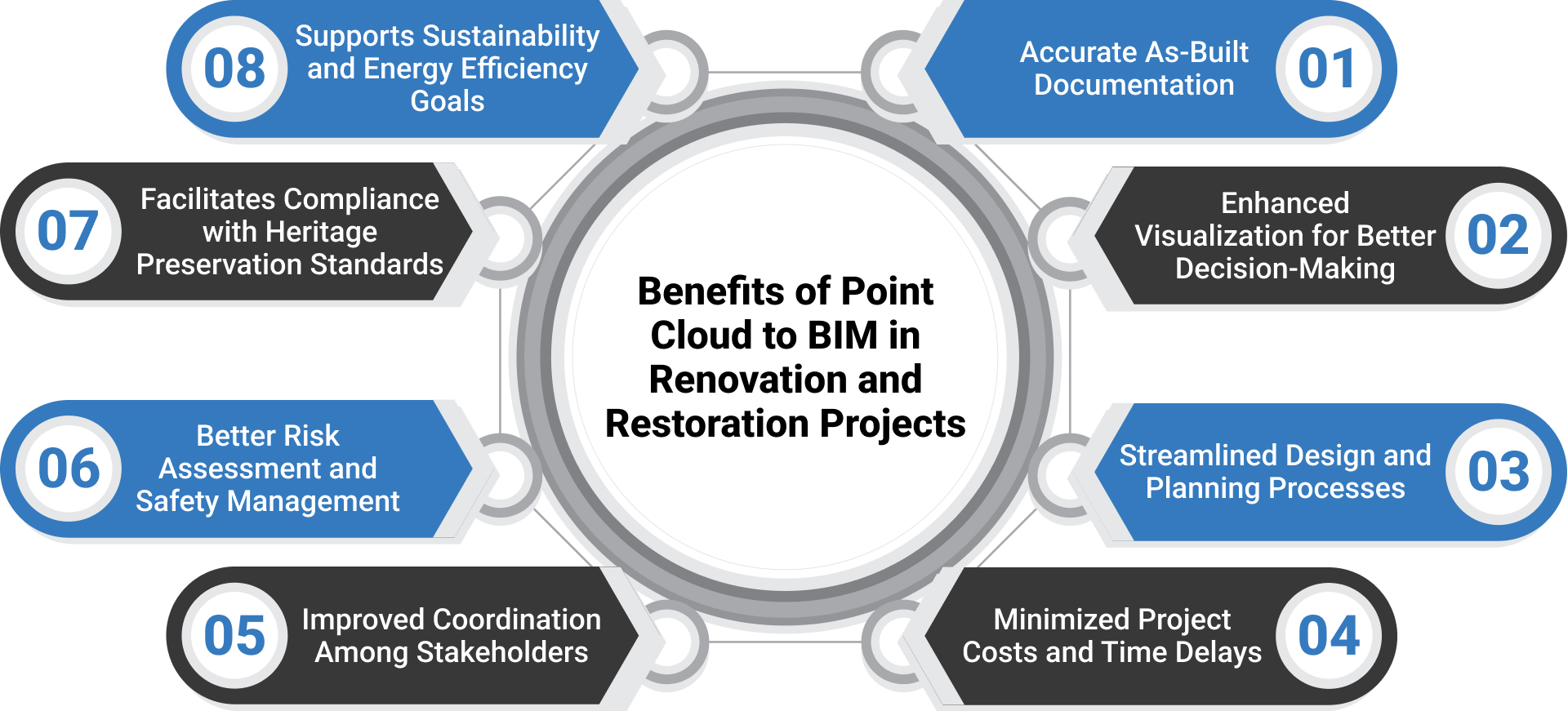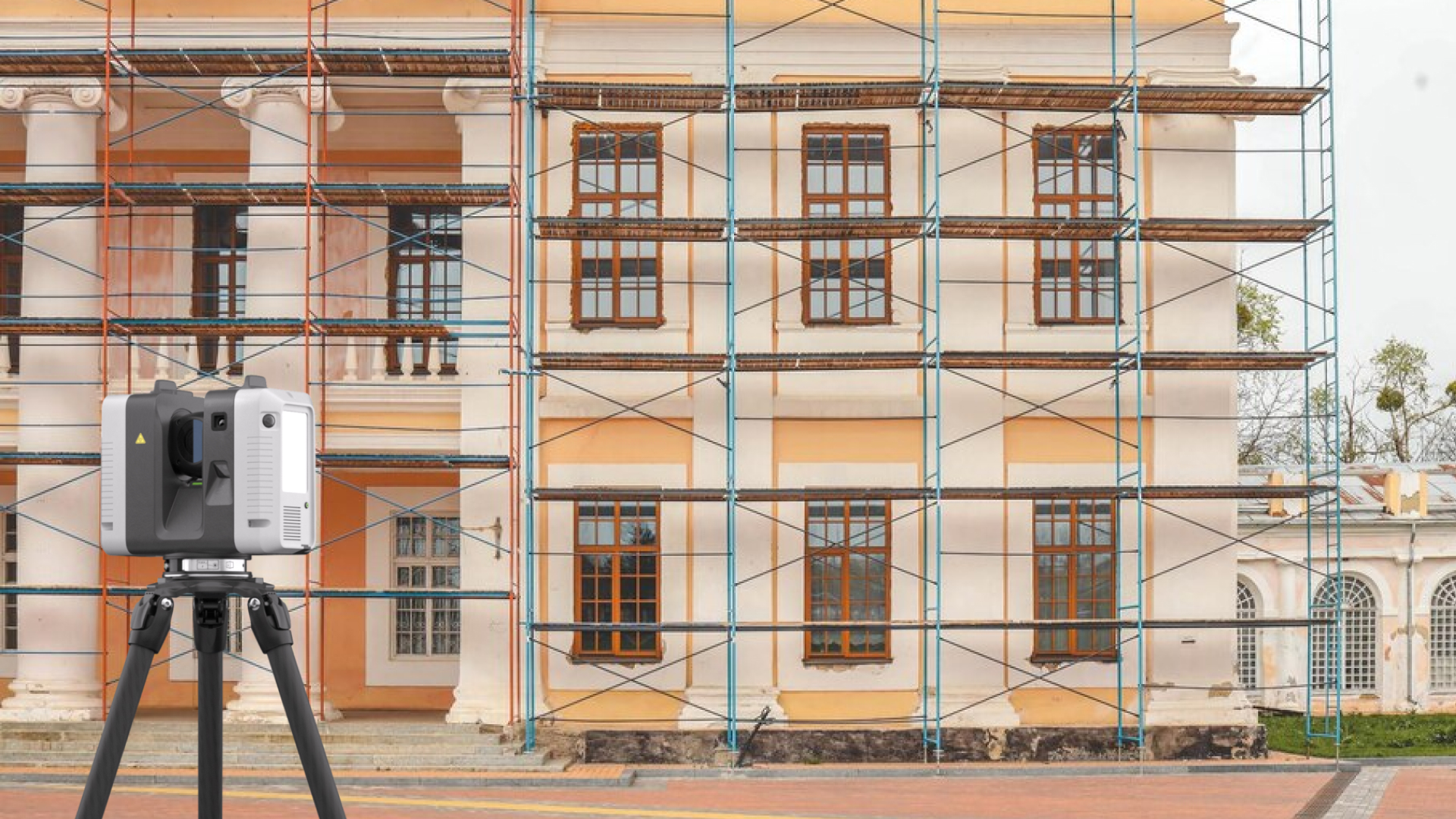Renovation and restoration projects often present unique challenges, from accurately understanding the current state of structures to accommodating intricate architectural details. Traditional methods of measurement and documentation can fall short, leading to costly errors and delays. This is where Point Cloud to BIM (Building Information Modeling) comes in, offering a precise, data-rich approach that transforms physical spaces into accurate digital models.
In this article, we’ll explore how Point Cloud to BIM significantly enhances renovation and restoration projects, streamlining workflows, reducing rework, and delivering better project outcomes.
Benefits of Point Cloud to BIM in Renovation and Restoration Projects

Accurate As-Built Documentation
Creating an accurate as-built model is one of the most significant challenges in renovation and restoration. Traditional measurements can miss crucial details or suffer from inaccuracies, especially in complex or historic buildings. Point Cloud to BIM services offers precise as-built documentation, capturing every aspect of a building’s structure, from walls and windows to intricate architectural details.
This accuracy reduces the guesswork often associated with older buildings, allowing project teams to make informed decisions that respect the original structure.
Enhanced Visualization for Better Decision-Making
Point Cloud to BIM technology provides a detailed 3D model that enables all stakeholders to visualize the building’s current condition. Architects, engineers, and clients can walk through a digital twin of the structure, identifying areas that need repair or redesign and assessing how proposed changes will look and function. This enhanced visualization capability improves decision-making by giving a clear picture of the renovation’s impact before any physical work begins.
Streamlined Design and Planning Processes
Using Point Cloud to BIM allows design teams to work directly with accurate digital models, speeding up the design and planning stages. Designers can avoid conflicts between the new design and existing elements, such as walls, beams, or plumbing systems. With an accurate model, architects and engineers can anticipate and resolve clashes in the early design phase, leading to more efficient, cost-effective renovations.
Minimized Project Costs and Time Delays
Errors in renovation projects can lead to significant cost overruns and time delays. With Point Cloud to BIM, accurate data from the start minimizes the likelihood of unexpected discoveries or clashes during construction. By catching potential issues in the planning stage, teams can avoid costly rework and project delays, keeping renovation and restoration work on budget and on time.
Improved Coordination Among Stakeholders
Point Cloud to BIM models make coordinating between various stakeholders, including architects, contractors, engineers, and project managers more accessible. With a centralized 3D model, team members can access a single source of truth, enabling seamless communication and reducing the chance of misunderstandings or misalignments. This collaborative approach is particularly beneficial in complex renovation projects where various systems must work harmoniously.
Better Risk Assessment and Safety Management
Point Cloud to BIM enables better risk assessment for older buildings or those with structural challenges by highlighting potential structural issues and fragile areas. Contractors and engineers can analyze the model to identify safe entry points, assess load-bearing elements, and design safer work processes. This proactive approach improves site safety, protecting workers and preserving the building’s integrity during the restoration.
Facilitates Compliance with Heritage Preservation Standards
In historical or heritage preservation projects, strict guidelines govern how renovations must be handled. Point Cloud to BIM is beneficial in these cases, as it provides a highly accurate, non-invasive way to capture and model historic buildings without damaging the structure. The digital model allows preservationists to work within heritage guidelines, ensuring that the renovation respects the original architectural elements and materials while allowing for modernization.
Supports Sustainability and Energy Efficiency Goals
Renovation and restoration projects increasingly focus on sustainability, aiming to improve energy efficiency and reduce environmental impact. Using Point Cloud to BIM, designers can simulate various energy-saving measures within the existing structure. By modelling potential upgrades in insulation, HVAC systems, or lighting, project teams can make data-driven decisions that improve a building’s energy efficiency, aligning with sustainable building goals.
Practical Tips for Implementing Point Cloud to BIM in Renovation Projects

As renovation and restoration projects increasingly adopt Point Cloud to BIM technology, here are some practical tips for successful implementation:
Choose the Right Technology
Investing in the appropriate scanning technology is crucial. Depending on the project’s scale and requirements, you can choose between ground-based laser scanners, drone-based photogrammetry, or handheld scanners. Each technology has its advantages and disadvantages, so assess the specific needs of your renovation project before making a choice.
Engage Experienced Professionals
Working with professionals with expertise in laser scanning and BIM modelling is essential. Collaborating with a skilled team ensures the data is captured accurately and the BIM model is effectively constructed. Look for firms with experience in similar projects, as their insights can save time and resources.
Invest in Training
If your team is unfamiliar with Point Cloud and BIM processes, consider investing in training sessions or workshops. Ensuring your team is well-versed in the latest technology and methodologies will maximize efficiency and reduce the likelihood of errors.
Plan for Data Management
Handling point cloud data can be complex due to its size and complexity. Develop a clear data management plan for organizing, storing, and sharing point cloud files. Effective data management is critical for collaboration and maintaining the project’s integrity.
Prioritize Collaboration
Foster a collaborative environment among architects, engineers, contractors, and other stakeholders throughout the project. Cloud-based BIM platforms can enhance communication and streamline workflows, allowing all team members to access the same up-to-date model.
Incorporate Feedback Loops
Integrate feedback loops throughout the project to ensure all stakeholders can contribute their insights and concerns. Reviewing the BIM model and point cloud data helps catch potential issues early and refine the design iteratively.
Document Changes and Updates
As renovations progress, document any changes made to the original design and the reasons behind those changes. Keeping an updated record of alterations not only aids in project tracking but also serves as a valuable reference for future renovations or maintenance.
Utilize Model-Based Simulations
Use the BIM model for simulations to assess various scenarios, such as construction sequences, energy efficiency improvements, and structural assessments. These simulations can help identify the best strategies for executing the renovation while minimizing disruption to existing operations.
Conclusion
Point Cloud to BIM has transformed how renovation and restoration projects are approached, offering unparalleled accuracy, efficiency, and cost savings. From documenting historical landmarks to modernizing commercial spaces, this technology empowers project teams to overcome challenges and achieve results that respect the building’s past while preparing it for the future.
For anyone planning a renovation, especially in complex or historical settings, adopting Point Cloud to BIM offers a powerful way to ensure that the outcome aligns with both the design vision and the structural realities of the building. As the construction industry moves toward digital transformation, Point Cloud to BIM will remain a cornerstone of innovative and effective renovation practices.


Recent Comments